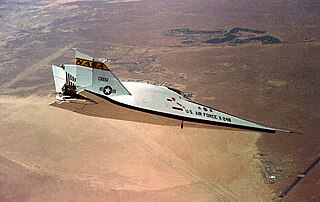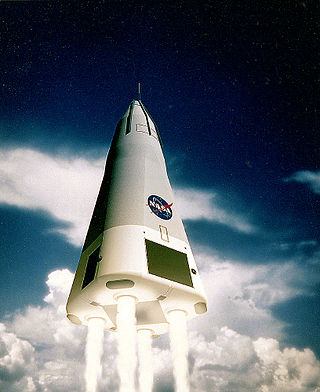
The Space Shuttle is a retired, partially reusable low Earth orbital spacecraft system operated from 1981 to 2011 by the U.S. National Aeronautics and Space Administration (NASA) as part of the Space Shuttle program. Its official program name was Space Transportation System (STS), taken from a 1969 plan for a system of reusable spacecraft where it was the only item funded for development.

A single-stage-to-orbit (SSTO) vehicle reaches orbit from the surface of a body using only propellants and fluids and without expending tanks, engines, or other major hardware. The term usually, but not exclusively, refers to reusable vehicles. To date, no Earth-launched SSTO launch vehicles have ever been flown; orbital launches from Earth have been performed by either fully or partially expendable multi-stage rockets.

The aerospike engine is a type of rocket engine that maintains its aerodynamic efficiency across a wide range of altitudes. It belongs to the class of altitude compensating nozzle engines. Aerospike engines have been studied for several years and are the baseline engines for many single-stage-to-orbit (SSTO) designs and were also a strong contender for the Space Shuttle main engine. However, no such engine is in commercial production, although some large-scale aerospikes are in testing phases.

The Martin Marietta X-24 was an American experimental aircraft developed from a joint United States Air Force-NASA program named PILOT (1963–1975). It was designed and built to test lifting body concepts, experimenting with the concept of unpowered reentry and landing, later used by the Space Shuttle. Originally built as the X-24A, the aircraft was later rebuilt as the X-24B.

The NASA Neil A. Armstrong Flight Research Center (AFRC) is an aeronautical research center operated by NASA. Its primary campus is located inside Edwards Air Force Base in California and is considered NASA's premier site for aeronautical research. AFRC operates some of the most advanced aircraft in the world and is known for many aviation firsts, including supporting the first crewed airplane to exceed the speed of sound in level flight, highest speed by a crewed, powered aircraft, the first pure digital fly-by-wire aircraft, and many others. AFRC operates a second site next to Air Force Plant 42 in Palmdale, California, known as Building 703, once the former Rockwell International/North American Aviation production facility. There, AFRC houses and operates several of NASA's Science Mission Directorate aircraft including SOFIA, a DC-8 Flying Laboratory, a Gulfstream C-20A UAVSAR and ER-2 High Altitude Platform. As of 2023, Bradley Flick is the center's director.

A spaceplane is a vehicle that can fly and glide like an aircraft in Earth's atmosphere and maneuver like a spacecraft in outer space. To do so, spaceplanes must incorporate features of both aircraft and spacecraft. Orbital spaceplanes tend to be more similar to conventional spacecraft, while sub-orbital spaceplanes tend to be more similar to fixed-wing aircraft. All spaceplanes to date have been rocket-powered but then landed as unpowered gliders.

VentureStar was a single-stage-to-orbit reusable launch system proposed by Lockheed Martin and funded by the U.S. government. The goal was to replace the Space Shuttle by developing a re-usable spaceplane that could launch satellites into orbit at a fraction of the cost. While the requirement was for an uncrewed launcher, it was expected to carry passengers as cargo. The VentureStar would have had a wingspan of 68 feet (20.7 m), a length of 127 feet (38.7 m), and would have weighed roughly 1000 t.

The Lockheed Martin X-33 was a proposed uncrewed, sub-scale technology demonstrator suborbital spaceplane that was developed for a period in the 1990s. The X-33 was a technology demonstrator for the VentureStar orbital spaceplane, which was planned to be a next-generation, commercially operated reusable launch vehicle. The X-33 would flight-test a range of technologies that NASA believed it needed for single-stage-to-orbit reusable launch vehicles, such as metallic thermal protection systems, composite cryogenic fuel tanks for liquid hydrogen, the aerospike engine, autonomous (uncrewed) flight control, rapid flight turn-around times through streamlined operations, and its lifting body aerodynamics.

The Orbital Sciences X-34 was intended to be a low-cost testbed for demonstrating "key technologies" that could be integrated into the Reusable Launch Vehicle program. It was intended to be an autonomous pilotless craft powered by a "Fastrac" liquid-propellant rocket engine, capable of reaching Mach 8 and performing 25 test flights per year.

The DC-X, short for Delta Clipper or Delta Clipper Experimental, was an uncrewed prototype of a reusable single-stage-to-orbit launch vehicle built by McDonnell Douglas in conjunction with the United States Department of Defense's Strategic Defense Initiative Organization (SDIO) from 1991 to 1993. Starting 1994 until 1995, testing continued through funding of the US civil space agency NASA. In 1996, the DC-X technology was completely transferred to NASA, which upgraded the design for improved performance to create the DC-XA. After a test flight of DC-XA in 1996 resulted in a fire, the project was canceled.

A rocket-powered aircraft or rocket plane is an aircraft that uses a rocket engine for propulsion, sometimes in addition to airbreathing jet engines. Rocket planes can achieve much higher speeds than similarly sized jet aircraft, but typically for at most a few minutes of powered operation, followed by a gliding flight. Unhindered by the need for oxygen from the atmosphere, they are suitable for very high-altitude flight. They are also capable of delivering much higher acceleration and shorter takeoffs. Many rocket aircraft may be drop launched from transport planes, as take-off from ground may leave them with insufficient time to reach high altitudes.

Romanian Cosmonautics and Aeronautics Association, also known as ARCAspace, is an aerospace company based in Râmnicu Vâlcea, Romania. It builds rockets, high-altitude balloons, and unmanned aerial vehicles. It was founded in 1999 as a non-governmental organization in Romania by the Romanian engineer and entrepreneur Dumitru Popescu and other rocket and aeronautics enthusiasts. Since then, ARCA has launched two stratospheric rockets and four large-scale stratospheric balloons including a cluster balloon. It was awarded two governmental contracts with the Romanian government and one contract with the European Space Agency. ARCASpace is currently developing a three-stage, semi-reusable steam-powered rocket called EcoRocket and in 2022 has shifted its business model to Asteroid mining.
Douglas Aircraft's SASSTO, short for "Saturn Application Single Stage to Orbit", was a single-stage-to-orbit (SSTO) reusable launch system designed by Philip Bono's team in 1967. SASSTO was a study in minimalist designs, a launcher with the specific intent of repeatedly placing a Gemini capsule in orbit for the lowest possible cost. The SASSTO booster was based on the layout of the S-IVB upper stage from the Saturn family, modified with a plug nozzle. Although the SASSTO design was never followed up at Douglas, it is widely referred to in newer studies for SSTO launchers, notably the MBB "Beta" design, which was largely an updated version of SASSTO.

A rocket sled launch, also known as ground-based launch assist, catapult launch assist, and sky-ramp launch, is a proposed method for launching space vehicles. With this concept the launch vehicle is supported by an eastward pointing rail or maglev track that goes up the side of a mountain while an externally applied force is used to accelerate the launch vehicle to a given velocity. Using an externally applied force for the initial acceleration reduces the propellant the launch vehicle needs to carry to reach orbit. This allows the launch vehicle to carry a larger payload and reduces the cost of getting to orbit. When the amount of velocity added to the launch vehicle by the ground accelerator becomes great enough, single-stage-to-orbit flight with a reusable launch vehicle becomes possible.
The Reusable Booster System (RBS) was a United States Air Force research program, circa 2010 to 2012, to develop a new prototype vertical-takeoff, horizontal-landing (VTHL) reusable booster and a new prototype expendable second stage to replace the existing Evolved Expendable Launch Vehicles (EELV) after 2025. The program was discontinued in 2012.
Aircraft can have different ways to take off and land. Conventional airplanes accelerate along the ground until sufficient lift is generated for takeoff, and reverse the process to land. Some airplanes can take off at low speed, this being a short takeoff. Some aircraft such as helicopters and Harrier jump jets can take off and land vertically. Rockets also usually take off vertically, but some designs can land horizontally.

SpaceX manufactures launch vehicles to operate its launch provider services and to execute its various exploration goals. SpaceX currently manufactures and operates the Falcon 9 Full Thrust family of medium-lift launch vehicles and the Falcon Heavy family of heavy-lift launch vehicles – both of which powered by SpaceX Merlin engines and employing VTVL technologies to reuse the first stage. As of 2020, the company is also developing the fully reusable Starship launch system, which will replace the Falcon 9 and Falcon Heavy.

The Lockheed Martin SR-72, colloquially referred to as "Son of Blackbird", is an American hypersonic UAV concept intended for intelligence, surveillance and reconnaissance (ISR) proposed privately in 2013 by Lockheed Martin as a successor to the retired Lockheed SR-71 Blackbird. The company expected an SR-72 test vehicle could fly by 2025.

During the lifetime of the Space Shuttle, Rockwell International and many other organizations studied various Space Shuttle designs. These involved different ways of increasing cargo and crew capacity, as well as investigating further reusability. A large focus of these designs were related to developing new shuttle boosters and improvements to the central tank, but also looked to expand NASA's ability to launch deep space missions and build modular space stations. Many of these concepts and studies would shape the concepts and programs of the 2000s such as the Constellation, Orbital Space Plane Program, and Artemis program.

















